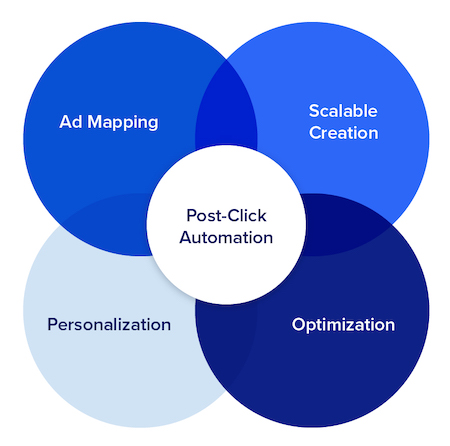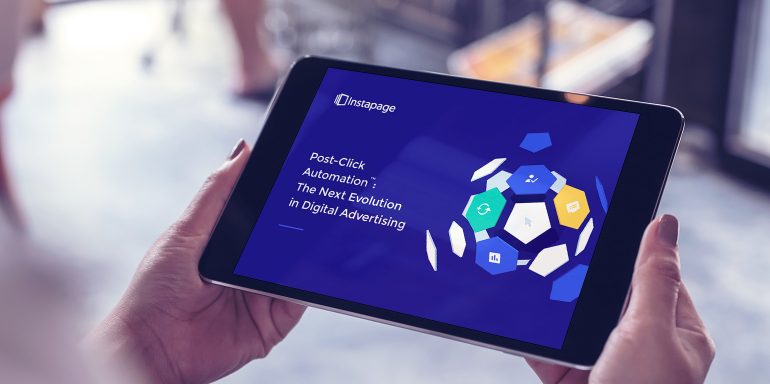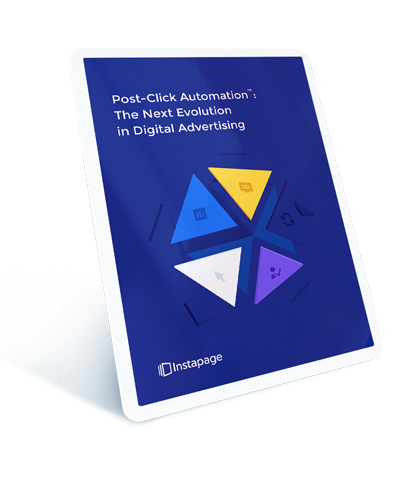Today, advertisers are blessed with more information than ever. They have more sophisticated tools, more complex strategies. They are unbound by geographical location, able to assemble expert teams across the globe.
Despite advantages like these, however, conversions remain an elusive goal.
Around 96% of traffic does not convert. On the Google Display Network, the average conversion rate doesn’t reach 1%. On the search network, it hovers just below 4%.
There’s a major problem with digital ad campaigns, and it lies in the post-click landing page.
The problem with the post-click landing page
Once an internet user clicks an advertisement, they find themselves in the post-click landing page. This is the stage in which they decide to convert or abandon an offer.
And although the goal of an ad campaign is almost always conversion, this stage of the funnel has been largely neglected by advertisers. There are a few reasons:
- Traditional advertising was primarily focused on the ad. Whether it was direct mail or a TV spot, it was an ad that sold the product. Today, the job of an ad is different. It’s to drive users to a post-click page where they can fully evaluate the offer. Anyone who attempts to translate traditional advertising strategies to the internet will find that they do not work on the digital user.
- Most technologies have focused on the pre-click. This makes sense considering the last point. If you approach digital advertising the way you do offline advertising, the most important aspect of the campaign is to get someone to positively react to your advertisement. This is accomplished through complex targeting tools, ad placement tech, modules for testing, etc. These types of tools have dominated the martech landscape over the last decade or so.
But users expect more than a personalized pre-click experience. A targeted ad campaign is worthless if it directs a user to a generic experience after they click the ad.
This gap in personalization has become a major killer of conversion rate. To bridge that gap comes a new kind of technology, known as Post-Click Automation™ (download the free ebook here or click the image):
What is post-click automation?
Post-click automation™ (PCA) is a category of marketing technology that allows marketers to maximize advertising conversions. It accomplishes this by automating the post-click stage in the advertising funnel, enabling 1:1 personalized post-click landing pages at scale.
PCA software is composed of four pillars: automation, scalable creation, optimization, and personalization:

Together, they promise to unite the already personalized pre-click stage with a personalized post-click stage, creating a unified, end-to-end journey that starts with the click and ends with the completion of your conversion goal. To do so, it will rely on tools like ad mapping, optimization, personalization, and scalability.
Ad mapping allows marketers to connect their PCA platform to ad networks, making it easy to visualize the funnel and track each ad-page combination. From there, users can edit a page’s automated layout via an intuitive builder connected to their CMS. This ensures the highest level of relevance between each ad and page.
As traffic to the page grows, optimization tools like heat maps and quantitative dashboards sort data, revealing opportunities for design improvement. To test those improvements, users will have automated experimentation and hypotheses at their disposal. This makes the technicalities of A/B testing nearly effortless.
After gathering on-page data about an audience, personalization tools will help users create experiences tailored to the design preferences of that segment. Where one might prefer a simple layout featuring video, another might prefer a text heavy-page with infographics. This increases relevance and likelihood of conversion.
Finally, scalability tools allow for the implementation of this relevance across groups of pages. With mass editing capabilities, users can adjust any element across groups of pages to maintain the most updated content for each target audience.
See how Post-click automation helps agencies to increase their productivity.
helps agencies to increase their productivity
Why is post-click automation a new category?
At first glance, PCA looks similar to a lot of other technology. You might confuse it for a CRO tool or a landing page builder, even an analytics solution.
PCA, however, is in a category of its own. Here’s what makes it unique:
1. Post-click automation unifies capabilities.
The capabilities offered by PCA software can only otherwise be found in individual best-in-class solutions. Similar to the way marketing automation unified capabilities (like lead scoring, journey mapping, bulk emailing, etc.) from multiple software, post-click automation combines tools never before seen in one platform. Post-click landing page building, A/B testing, demand gen forms, heatmaps, personalization, and CMS are all available to PCA users.
2. PCA modernizes the advertising funnel.
Post-click automation brings a long-overdue update to digital marketing strategies, emphasizing personalization throughout the funnel. Where most solutions offer pre-click tools, or individual post-click tools, no one platform connects the pre-click and post-click landing pages in a streamlined fashion. From click to conversion, PCA allows marketers to focus efforts across technologies on one funnel stage at a time.
3. Post-click automation simplifies operations.
Combining solutions into one robust platform does more than offer advertisers power; it offers them simplicity, too. Instead of manual-enter spreadsheets, users get ad mapping. Instead of integrations with heatmaps and testing tools, users get them built-in. As opposed to fumbling with countless tools, integrations, decisions, purchases, users bypass it all with a comprehensive, end-to-end platform.
What is the market gap that this category fills?
With over 7,000 marketing technologies available, it may be hard to imagine where PCA fits. The pre-click stage has advertising tools for targeting, creating, and running ads. Sales has customer relationship management. For lead qualification, there are automated emails.
But when you map out the stages of the advertising funnel, you become clear of the gap that PCA fills:

In each stage of the funnel, technology exists for personalizing the user experience. The goal of that technology varies based on where it’s deployed.
The only stage without such a technology is the post-click. And this is where scalability and personalization completely break down. Attempts have been made to remedy this, but so far, alternatives have failed.
What are the existing alternatives to post-click automation software?
Of course, while PCA provides an all-in-one solution for unifying the ad campaign, there are existing alternatives. Each alternative, however, has critical weaknesses that hinder the ultimate goal of a scalable, personalized advertising experience throughout the entire campaign.
- Developers can code a page with advanced features, but this cannot be completed under time constraints. PPC marketers need to be empowered to create post-click landing pages in minutes because they must move at the speed of advertising. When developers can take weeks to deliver a page, this option is better suited for static, evergreen assets like a corporate website.
- Marketing Automation tools allows marketers to publish basic lead capture pages that are suitable for qualifying leads. To create anything beyond a basic lead capture page, marketers need a developer. Marketing automation tools are best for lead nurturing and for static, evergreen lead capture pages that allow leads to click an email and complete registration.
- CMS solutions allow marketers to create web pages through pre-coded templates featuring substitutional content. To create a new template, however, requires coding. That can take weeks, and there are no alternatives. CMS solutions don’t offer a visual editor. They don’t have conversion features like heatmaps, A/B testing, personalization, conversion goals, or conversion-focused integrations. To set up these capabilities, you need developers. CMS solutions are best suited for website pages that are static and don’t need to be updated iteratively and quickly.
- Optimization and personalization tools can’t meet the page creation requirement of PCA. Even category leaders require heavy coding, making them heavily time-consuming. This makes optimization and personalization initiatives the privilege of large companies with dedicated teams of developers. It has yet to reach the masses.
(Bonus: Download the post-click automation guide for three additional alternatives and why they, too, are not suited for PCA.)
Get the Post-Click Automation ebook here
Running a successful advertising campaign requires a balanced pre- and post-click landing page. For every targeted ad you create, there should be an equally targeted post-click landing page. More relevance means better results.
Just a year or two ago, unifying the ad campaign this way would’ve seemed outlandish. Today, you can do it with post-click automation. Learn more about how it’s possible with the new Instapage ebook: Post-Click Automation™: The Next Evolution in Digital Advertising.

